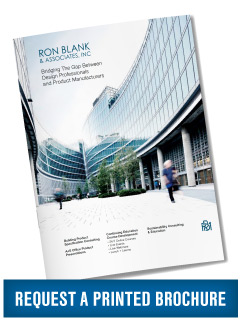Follow up! A point person in your office will receive lead reports containing the contact information of everyone who has participated in your online program or webinar. Participation indicates an interest in your product/service. We generally recommend a “Thank You For Participating in Our Course” email with any additional literature you might want to include or perhaps even a call to action and incentive. Personalization is also effective and meaningful, so you may want to delegate a specific rep in that participants area to follow up and simply lend themselves as a resource (What questions do you have? How can I be of service?). With webinars, attendees are able to ask questions during the webinar, so this can provide a guide for you during follow up in terms of what a potential lead is looking for. But time is of the essence. Therefore, someone on your staff must be able to quickly follow up on these leads. This helps establish a relationship between your company and the design professional after they have completed your program.

FAQ for Continuing Education
The world of continuing education for design professionals is littered with multiple requirements, organizations and acronyms. Let us help you navigate through this landscape. There are some frequently asked questions that usually come to mind which we have answered below, but if you want to understand more about how your company can directly benefit from the opportunity of presenting an accredited continuing education (CE) course to architects, spec writers and other design professionals, please fill out the form below and to the right and one of our CE specialists will contact you shortly.
|
|
|
Beyond developing an engaging and compelling CE program, RBA’s affiliate InfoSpec, Inc. can assist you through the AIA provider registration process (AIA requires that your company become a provider for in-person delivery). We can also register your course other relevant organizations under our providership umbrella. But we also just take all the work off your hands in terms of registration, simplified attendance reporting, credit reporting on your behalf, certificate distribution, and record keeping. |
|
Architects in most U.S. states and Canadian provinces must meet Mandatory Continuing Education (MCE) requirements for licensure. Eventually all states will require MCE. All architects who are AIA members must complete 18 Learning Units (LU’s) annually to retain their membership. A learning unit represents approximately one hour of study time. Twelve of those LU’s must be of Health, Safety, and Welfare (HSW) designation, which is a quality standard set by the Architectural Record Examiners board, (ARE). And there are many other credentialing associations that we work with that also require MCE hours. HSW and SD LUs are the most sought after credits by design professionals. SD courses are hosted at www.GreenCE.com provided by GreenCE, Inc. Ron Blank & Associates Inc. and GreenCE, Inc. can create, host, manage, and market engaging, compelling courses for your company that have the HSW or SD designation. |
|
There are three general formats for delivery of CE programs: 1. Online/On Demand (module or video learning, available 24/7), 2. Webinar (live instructor, scheduled presentation online) 3. In Person/Lunch and Learn. Note that there are important distinctions between each format. If you have a lunch & learn course and you want to put it up on our online platform, it must be registered as an online program and converted to online format, and vice versa, per continuing education standards and guidelines set forth by states and credentialing associations.
|
|
The cost to sponsor and host a CE course is much cheaper compared to other marketing efforts. You get the most “bang for your buck” educating design professionals through a CE program. To determine the cost, we will have you fill out a course development form. The form will list all of the materials you have available to develop a CE course with such as digital photos, CAD details, video clips, case studies, as well as learning objectives. The more material you can provide to us, the less expensive the development costs. For example, you may already have a Powerpoint presentation that can be incorporated into a course. |





